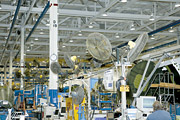

How about, say, 1,500 of them? They’re yellow, noisy, and a little shopworn. In fact, they’ve already served a useful life providing factory workers respite from the 100-plus degree heat during St. Louis summers.
One thing is for sure. The 800-plus workers in Building 101, a cavernous manufacturing facility on the Boeing St. Louis campus, are not likely to need any more, now that the building temperature is cooled to a tolerable 78?F or less.
This is the story of Building 101 and the new $17.4 million HVAC system that made those fans obsolete. It’s also the story of how to design and install such a system in a 40-year-old building, without disturbing the precision manufacturing going on all around.

The Decision To Modernize
Constructed in two phases in 1958 and 1962, L-shaped Building 101 came on-line well before air conditioning was a routine part of building construction. It stayed that way for the next four decades, while NASA Mercury mission parts, F-15 landing gear, and hundreds of other aircraft and spacecraft components wove their way through its frequently changing production lines.By 2001, however, Boeing had reason to look at Building 101 in a new light. The company had begun the process of consolidating and modernizing the space on its sprawling St. Louis campus. With its nearly 900,000 sq ft of manufacturing space, 30-ft-plus high ceilings and an open floor plan, Building 101 was well-worth preserving. Planners designated it to be one of the company’s primary St. Louis manufacturing centers.
Building 101 had just one big problem. It was the largest production facility on the St. Louis campus that lacked air conditioning. Given a choice, it wouldn’t be the first place most production line workers would choose to be on a hot summer day.
It also wasn’t an ideal environment for some manufacturing processes, particularly those that involved temperature-sensitive dissimilar metals or that demanded small tolerances. A temperature-controlled environment would potentially benefit the finished components coming from Building 101 as well.
After completing initial conceptual work and cost estimates in-house, Boeing had all the reasons it needed to retain the St. Louis office of Burns & McDonnell to design an HVAC system that would bring Building 101 into the 21st century.

A Planner’s Dream?
In many ways, Building 101 is a production planner’s dream space. It’s got high ceilings, no walls, and a wide open floor space. This is no accident. To make the environment as flexible as possible, the original building designers had located the building’s mechanical and electrical system components away from the production floor in the building’s overhead trusses.
A production planner’s dream, however, can also be a mechanical engineer’s nightmare. To the engineers charged with designing a cooling system, while replacing the existing heating and ventilation equipment, Building 101 posed a series of challenges and constraints.

Challenge #1: Where To Locate The New AHUs?
The existing units — all 54 of them — were located in the trusses of the roof structure, along with all of the building’s ductwork, utilities, conduit, and other system components. But were the rafters really the best place for the new units? That was the question Burns & McDonnell engineers asked the people of Service Center 3, the internal group of Boeing engineers and maintenance staff that would ultimately be responsible for operating and maintaining the system. Through a series of design review meetings, Burns & McDonnell developed a decision matrix that examined all the options.Maintenance personnel, understandably, preferred that the units be located on the plant floor, where they would be easier to access and maintain. In their current location, workers had to walk on catwalks above an active production floor, ducking beneath beams and pipes as they maneuvered toward the equipment.
The building’s overhead structure also posed several constraints, given that there was already a 40-year accumulation of utilities, conduit, and piping amassed in it. Would there be room enough for the substantial amount of additional equipment needed to cool more than 800,000 sq ft of space?
The plant’s production staff proffered a different point of view. Because of the changing nature of the manufacturing that takes place in Building 101, they had to be ready for frequent plant floor changes and the new production equipment that is regularly moved in and out of the space. They preferred a location for the AHUs that would not affect their current flexibility.
Ultimately, the design team chose a third option that everyone at the plant could agree on. The AHUs would be located on the building’s rooftop — away from both the plant ceiling and the floor.
Challenge #2: How To Design Them
In designing the new AHUs, engineers had to a lot to consider.To help control energy costs, Boeing set a target temperature of 78? for the production floor. Achieving this internal environment would require 28 custom-built AHUs, each delivering 45,000 cfm. Each completed unit would be massive by most standards — nearly 13 ft tall, 48 ft long, and 15 ft wide.
Then there was maintenance. Imagine a thunderstorm in 90? heat. Now imagine you’re the maintenance person called in to check out a problem with AHU #4. With the help of Boeing maintenance staff, Burns & McDonnell engineers imagined this — and all of sorts of other scenarios as they began design.
As a result, each unit is accessible from inside the plant through a hatch door at its base. Each unit also includes a 5-ft wide heated and air conditioned vestibule where technicians can check valves and perform other routine maintenance. Movable panels put all parts of a unit within easy reach. Even a service ladder is built in, enabling workers to change filters with relative ease.
Designers also had to consider the load-bearing capacity of the building’s roof structure. Boeing had requested a system design that would work with the building’s existing structural support system. The problem: the air-handling equipment needed to cool Building 101 would collectively weigh more than one million pounds.
To ensure the roof could support the additional weight, engineers created computer models of the roof structure. The models showed that the structure could indeed support the new equipment — as long as the existing units were removed from the building’s trusses first. Hence, construction was staged so that new units were installed as old units were dismantled and removed.
But before construction could begin, the team had to first figure out how to transport a million pounds of equipment to the roof. Had they been installing an HVAC system in a new building, contractors could have staged construction so the units could be installed as the building went up. Transporting the units to the roof of an existing, operating building, however, required some design gymnastics of its own.
To help ensure the constructability, and the transportability, of its designs, Burns & McDonnell asked Corrigan Company Mechanical Contractors in St. Louis to join the team as the project’s mechanical contractor early on.
The team specified that each unit be premanufactured in four 8-ft sections. Each section was designed to meet the weight and size limitations of the trucks, helicopters, and cranes that would transport them to their final rooftop locations. Their length and width, for example, were limited to dimensions that could be transported on a flatbed truck, while their height was dictated by the height of the bridge overpasses on the 240-mile trip from the factory in Springfield, MO to the Boeing plant in north St. Louis County. Similarly, each section had a maximum weight of 10,000 lbs — the amount of weight the helicopters could airlift to the rooftop once the units arrived at the plant.
Challenge #3: Out With The Old
By 2002, there was a 40-year accumulation of utilities, conduit, and piping — not to mention dust and debris — among the building’s trusses. Determining where to locate and route nearly two miles of replacement ductwork would not be easy.Simply replacing the ductwork in its existing location was not always a feasible solution. New ductwork often came in different shapes and diameters than the original. And engineers discovered that existing routes would not necessarily provide even temperature control throughout the building.
Complicating matters further were the large crane rails mounted to the roof structure. The crane rails were frequently used to move equipment around the production floor. To avoid impediment of movement, no pipes or ducts could run below the bottom chord of the roof structure, hence limiting placement.
Given these constraints, the engineers took a methodical approach, selecting routes that fit within the ceiling structure’s constraints, while also delivering the best airflow possible. Temperature sensors scattered throughout the plant floor helped by feeding into a computerized automation control system that modulates the heating and cooling coils.
On a busy production line, however, even a 78? environment may not seem “cool enough” to many workers. To increase air movement at the plant floor — while also keeping an eye on energy costs — engineers specified the installation of 41 high-volume, low-speed ceiling fans. The blades of the 14-ft-dia fan can each push 100,000 cfm of air, helping to increase the comfort level on the production lines below.
Engineers also sought to keep humidity in the plant as low as possible, without having to add special dehumidification equipment. Ordinarily, moisture in the air is removed by using electricity, steam, or hot water to reheat the air leaving the cooling coils.
In this case, however, Burns & McDonnell added a return air bypass duct around the coiling coil in the AHU to create a “free” reheat system. A portion of the warm return air that returns through the duct is used to reheat the air leaving the cooling coil, helping to remove hundreds of gallons of moisture from the air each day and yet maintain comfortable temperatures.
Challenge #4: How To Work Around 24/7 Operations
At the back of engineers’ minds on every decision was a simple reality: Whatever solutions they proposed, they would need to be implemented amid the sensitive, around-the-clock production of aircraft and spacecraft parts.That meant figuring how to work about 30 ft directly above the factory floor, around ongoing operations. It also meant preventing tools, paint chips, metal, or any other foreign object debris from falling to the busy factory floor while old systems were moved and new ones installed.
Working with Alberici Constructors construction manager Gary Gossett and Boeing construction manager Lisa Johnson, engineers devised a plan to create rolling platforms for the construction crews. Mounted on the existing crane rails overhead, each 50-ft by 10-ft plywood and steel platform included 4-ft sides for storing ductwork as it was disassembled. Not only did the platforms make it easier for workers to access the roof structure, but they also protected the production floor from any debris removed or shaken loose during the construction process.
Work on the platforms was performed largely at night, when there were fewer Boeing employees at work and construction crews would be less likely to disrupt production below. Over the course of nine months, workers removed the original AHUs and ductwork before installing more then 10,000 ft— nearly two miles — of ductwork, some of which was more than 7 ft in width.
More than 160,000 man-hours later, in the summer of 2003, the project was complete, and all without a single lost-time accident.
